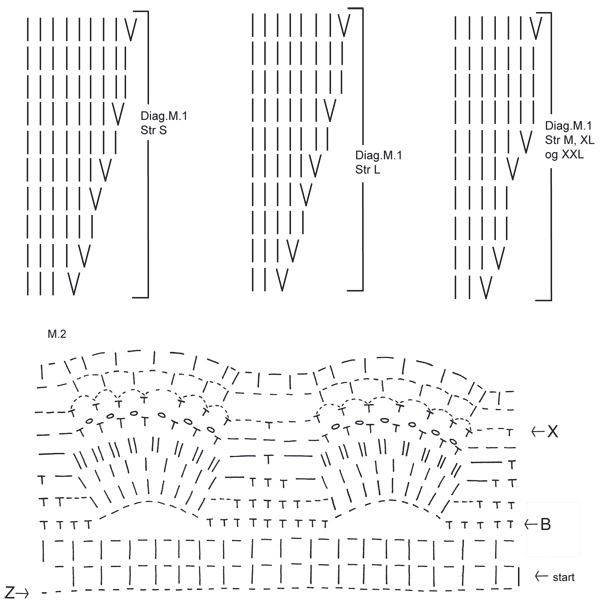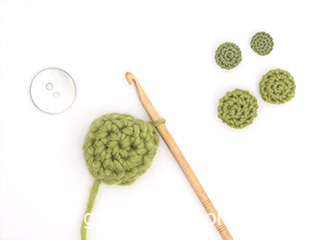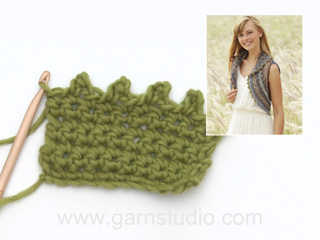Brooke |
||||||||||||||||||||||
|
|
||||||||||||||||||||||
DROPS crochet jacket with mussel pattern in “Alpaca” and “Cotton Viscose”. Size S - XXL
DROPS 99-1 |
||||||||||||||||||||||
|
GAUGE: 14 dc x 7 rows with 1 strand of each quality = 10 x 10 cm [4" x 4"]. 1 repeat of mussel pattern = width approx 11 cm [4⅜"]. CROCHET INFO: At the beg of each round replace the first dc with ch 3. Replace first tr with ch 4. Finish each round with 1 sl st in 3rd/4th ch from beg of round. PATTERN: See diagrams M.1 and M.2. The diagram is seen from the RS. MEASURING TIPS: Because of the weight of the yarn all measurements should be made whilst the garment is hanging. _______________________________________________________________ BODY: The jacket is crochet from the top down and back and forth with opening mid front. Loosely ch 92-97-97-105-113 (includes 3 ch to turn with) on crochet hook size 4.5 mm [US 7] with 1 strand Alpaca and 1 strand Cotton Viscose (double strands held together). Crochet next row as follows: 1 dc in 4th ch, *skip 1 ch, 1 dc in each of the next 3 ch*, repeat from *-* (in size M, L, XL and XXL finish with 1 dc in the last ch) = 68-72-72-78-84 dc – see Crochet info. On next row work 1 dc in each dc and at the same time inc 14-13-10-19-19 dc (inc by working 2 dc in 1 dc) evenly on row (do not inc on 5 dc each side = front bands) = 82-85-82-97-103 dc. Now crochet 10 rows following chart M.1 (5 dc each side = front bands and are not to be part of diagram, on these sts work 1 dc in each dc). After chart M.1 there are 190-210-226-242-258 dc on row. Continue with 1 dc in each dc until piece measures 20-21-23-23-24 cm [8"-8 ¼"-9"-9"-9½"]. Crochet next row as follows: 5 dc on front band, 26-28-31-35-39 dc (= front piece), ch 7-8-8-8-9 (under arm), skip 38-45-45-45-45 dc from previous row (= armhole, sts to be used later for sleeve), 52-54-64-72-80 dc (= back piece), ch 7-8-8-8-9 (under arm), skip 38-45-45-45-45 dc from previous row (= armhole, sts to be used later for sleeve), 26-28-31-35-39 dc ( = front piece), 5 dc on front band. Next row: crochet 1 dc in each dc and each ch = 128-136-152-168-186 dc. On next row work 1 dc in each dc and at the same time inc 9-19-21-23-23 dc evenly = 137-155-173-191-209 dc. Then crochet 1 row with 1 sc in each dc (also on sts on front bands) and then continue following chart M.2 (beg at arrow in diagram). Work 1 vertical repeat of chart M.2, and begin the second repeat by Arrow B in diagram. After second repeat om M.2 the piece measures approx 44-45-46-47-48 cm [17 ¼"-17 ¾"-18"-18½"-19"]. Now crochet 3-3-4-4-4 rows of tr as follows (also on front band sts): Row 1: Remember crochet info! Work 1 tr in each ch-space, and ch 1 between each tr, finish row with 1 tr in the last st = 64-73-82-91-100 tr + 5 tr on each front band. Row 2: 1 tr in each tr from previous row, but now ch 2 between each tr (instead of 1). Row 3: 1 tr in each tr from previous row, but now ch 3 between each tr. Note – finish size S and M here and skip row 4 below = 64-73 tr + + 5 tr on each front band. Row 4 (Size L - XL – XXL): 1 tr in each tr from previous row with ch 3 between each tr. Note - finish size L, XL and XXL here = 82-91-100 tr + 5 tr on each front band. All sizes: Now crochet diagram M.2 again (beg at start arrow in diagram). Note! Crochet row 1 in M.2 as follows to make pattern fit (work 5 front band sts each side as before): 5 band sts, ch 1, 1 dc in the first tr, ch 1, *1 dc in the next tr, ch 1, 1 dc in ch-space, ch 1*, repeat from *-* = 126-144-162-180-198 ch-spaces (i.e. 14-16-18-20-22 repeats of mussel pattern at bottom of jacket). End working the pattern after row 7. Fasten off. Sleeve: Crochet from armhole towards bottom edge. Beg mid under arm as follows: crochet 1 sc in the 4th -5th -5th -5th -5th ch of the 7-8-8-8-9 ch worked under the arms on front and back piece. Ch 3 (= 1 dc) and continue with 1 dc in each ch. Note! Before continuing working around armhole crochet 1 dc in the transition to avoid a hole. Continue with 1 dc in each dc along armhole and crochet 1 dc in the transition before crocheting 1 dc in the remaining ch under the arm = 47-55-55-55-56 dc. Crochet in the round like this until sleeve piece measures 9-10-9-9-10 cm [3½"-4"-3½"-3½"-4"]. Now crochet next round as follows: Size S: Crochet 5 dc mid under arm, continue in M.2 (from start arrow in diagram) = 2 repeats of mussel pattern and finish with 6 dc. Crochet 1 vertical repeat of M.2. Now crochet 1 row of tr as follows: crochet in the first 5 dc like this: ch 4 (= 1 tr), *1 ch, skip 1 dc, 1 tr in the next dc*, repeat from *-*. Continue on mussel pattern like this: *ch 1, 1 tr in next dc*, repeat from *-*. Crochet in the last 6 dc like this: *ch 1, skip 1 dc, 1 tr in the next dc*, repeat from *-* = 23 ch-spaces. Size M + L + XL: Ch 3 and continue in M.2 (from start arrow in diagram) = 3 repeats of mussel pattern + 1 dc mid under arm. Crochet 1 vertical repeat of M.2. Now crochet 1 row of tr as follows: ch 4 (= 1 tr), ch 1, *1 tr in next dc, ch 1*, repeat from *-* and finish with 1 sl st in 4th ch from beg of round = 27 ch-spaces. Size XXL: Ch 3 and continue in M.2 (from start arrow in diagram) and finish with 1 dc mid under arm = 3 repeats of mussel pattern + 2 dc mid under arm. Crochet 1 vertical repeat of M.2. Now crochet 1 row of tr as follows: ch 4 (= 1 tr), ch 1, skip 1 dc, *1 tr in next dc, ch 1*, repeat from *-* and finish with 1 sl st in 4th ch from beg of round = 28 ch-spaces. All sizes: Now crochet 7-6-6-6-5 rounds as follows: ch 4 (= 1 tr), ch 1, 1 tr in the first tr, *ch 1, 1 tr in next tr*, repeat from *-* and finish with 1 sl st in the 4th ch from beg of round. After the last round crochet M.2 again (from start arrow in diagram), but crochet the first round as follows to make the pattern fit: Size S: ch 3 (= 1 dc), *ch 1, 1 dc in next ch-space, ch 1, 1 dc in the same ch-space, ch 1, 1 dc in the next ch-space*, repeat from *-* and finish with 1 sl st in the 3rd ch from beg of round. There are now 36 ch-spaces (= 4 repeats of mussel pattern at the bottom sleeve edge). Finish M.2 after row 7. Size M + L + XL: ch 3 (= 1 dc), *ch 1, 1 dc in next ch-space, ch 1, 1 dc in the next ch-space, ch 1, 1 dc in the next ch-space, ch 1, 1 dc in the same ch-space*, repeat from *-* and finish with 1 sl st in the 3rd ch from beg of round. There are now 36 ch-loops (= 4 repeats of mussel pattern at the bottom sleeve edge). Finish M.2 after row 7. Size XXL: ch 3 (= 1 dc), *ch 1, 1 dc in next ch-space, ch 1, 1 dc in the next ch-space, ch 1, 1 dc in the next ch-space, ch 1, 1 dc in the next ch-space, ch 1, 1 dc in the same ch-space*, repeat from *-* and finish with 1 sl st in the 3rd ch from beg of round. There are now 36 ch-spaces (= 4 repeats of mussel pattern at the bottom sleeve edge). Finish M.2 after row 7. Button covers: Crochet covers for 5-6-6-6-6 buttons on crochet hook size 3 mm [US C] with Cotton Viscose as follows: 1st round: ch 2, 16 dc in the first ch and finish with 1 sl st in first dc. 2nd round: 1 sc in each dc and finish with 1 sl st in first sc from beg of round. 3rd round: ch 3, 1 dc in every other sc and finish with 1 sl st in 3rd ch from beg of round = 8 dc Put button inside cover, sew round the opening and pull tight. Assembly: Sew on buttons to left front piece as follows: Size S: 1, 12, 23, 34 and 44 cm [3/8"-4 ¾"-9"-13⅜"-17 ¼"]. Size M: 1, 10, 19, 28, 37 and 45 cm [3/8"-4"-7½"-11"-14½"-17 ¾"]. Size L: 1, 10, 19, 28, 37 and 46 cm [3/8"-4"-7½"-11"-14½"-18"]. Size XL: 1, 10, 20, 29, 38 and 47 cm [3/8"-4"-8"-11⅜"-15"-18½"]. Size XXL: 1, 10, 20, 29, 39 and 48 cm [3/8"-4"-8"-11⅜"-15 ¼"-19"]. Crochet border: Beg at the bottom of right front band. Crochet 2 sc in each dc up along front band, crochet 1 sc in each dc round neckline and crochet down left front band as described for right front band. At the same time crochet buttonhole loops on right front band as follows: 5 ch, skip approx 2 cm [3/4"], 1 sc in next st (make sure to position the buttonhole loops in line with buttons on left front band). |
||||||||||||||||||||||
Diagram explanations |
||||||||||||||||||||||
|
||||||||||||||||||||||

|
||||||||||||||||||||||

|
||||||||||||||||||||||
|
Have you made this or any other of our designs? Tag your pictures in social media with #dropsdesign so we can see them! Do you need help with this pattern?You'll find tutorial videos, a Comments/Questions area and more by visiting the pattern on garnstudio.com. © 1982-2024 DROPS Design A/S. We reserve all rights. This document, including all its sub-sections, has copyrights. Read more about what you can do with our patterns at the bottom of each pattern on our site. |
||||||||||||||||||||||















































Comments / Questions (215)
Hva menes med en 5 st stolpe?
11.05.2023 - 19:47DROPS Design answered:
Hei Henriette, Hver stolpe består av 5 staver (som er tegnet inn i diagrammet) og er heklet med staver hele veien. God fornøyelse!
12.05.2023 - 06:40Ik ben bij de knoophoesjes. In het patroon staat:haak 2 lossen en dan 16 stokjes in de eerste losse. Eindig met een halve vaste in de eerste vaste. Maar dan heb ik geen vaste. In de video worden alleen vasten gehaakt. Wat kan ik nu aanhouden?
02.03.2023 - 13:26DROPS Design answered:
Dag Nancy,
Klopt, je hebt dan inderdaad geen vaste. Wat er bedoeld wordt is dat je de toer sluit met een halve vaste in het eerste stokje. Omdat het eerste stokje vervangen wordt door 3 lossen (zie info haken bovenaan het patroon), haak je dus een vaste in de derde van die 3 lossen.
02.03.2023 - 20:11Hello, some time ago I bought 8 balls of Bomull Lin yarn, as beginner crochet in lock down! I was planning to make a bag using one of your patterns, but it was too difficult for me at the time. I would now like so use the yarn for your Brooke pattern. Is this possible? I realise that the Alpaca yarn given is group A and Bomull lin is group C, and I am not clever enough to use your charts to convert! Could you help please?
12.02.2023 - 14:37DROPS Design answered:
Dear Susan, since you use 2 threads of group A yarns (Alpaca + Cotton viscose), you can substitute them and work with 1 thread of Bomull Lin (A+A = C). First try to work a gauge as indicated in the pattern, using a single thread of Bomull-Lin; if it matches, you can work this garment with it, without changing the number counts. However, take into account that you are working with a thicker thread, so you will require more than 400gr of Bomull Lin to make this garment. Also, the garment's texture will be different from the original. Happy crocheting!
12.02.2023 - 20:30Kunnen jullie me vertellen waar de correctie precies begint?
20.01.2023 - 23:51DROPS Design answered:
Dag Nancy,
De correctie staat in de kleine alinea boven de alinea van de mouw. In het online patroon is de correctie al doorgevoerd.
22.01.2023 - 17:33Nach welcher Reihe wird die Arbeit als Vorder und Rückenteil und Ärmel extra weiter gehäkelt ?
24.10.2022 - 22:45DROPS Design answered:
Liebe Dagmar, wenn die Arbeit 20-21-23-23-24 cm misst, häkeln Sie die Verteilung-Reihe. Viel Spaß beim häkeln!
25.10.2022 - 09:05Bonjour, pour les manches (taille S) : "continuer en suivant M2, à partir de la flèche sur le diagramme" : s'agit-il de la flèche "start" ou de la flèche B ? "2 motifs d'éventail" : 2 éventails complets c'est à dire les 9 rangs de M2 ?
20.03.2022 - 14:37DROPS Design answered:
Bonjour Laurence, il s'agit de la flèche "start" dans M.2 - et tout à fait, crochetez entièrement le diagramme pour avoir les 2 éventails en largeur et crochetez les 10 rangs de M.2 (en commençant par la flèche "start"). Bon crochet!
21.03.2022 - 08:38Merci pour vos explications, j'ai fini par m'en sortir! ;)
05.03.2022 - 15:32Bonjour, c'est quoi des "mailles de bordure devant"? des ms ?
24.02.2022 - 18:13DROPS Design answered:
Bonjour Laurence, ce sont les 5 mailles que vous avez crocheté depuis le début en brides, dans M.2 vous les crochetez en brides sur les rangs 1 et 2, puis en mailles serrées sur les rangs 3 à 8 et en brides sur les rangs 9 et 10 (toujours les 5 premières et les 5 dernières mailles). Bon crochet!
25.02.2022 - 08:48Bonjour, je crochète en taille S ; je n'ai pas fait ce que vous indiquez car je ne comprends pas ces instructions (j'imagine qu'il s'agit des corrections à faire pour ce modèle?) Dois-je commencer en B en remplaçant les 5 ms du diagramme M2 par 4 brides/ml +1bride avant de faire l'arceau de 9ml , puis continuer en 9 ms puis arceau de 9 ml puis 4 brides/ml +1bride ?
24.02.2022 - 14:17DROPS Design answered:
Bonjour Laurence, en S vous avez donc 137 mailles, vous crochetez: 5 mailles de bordure devant, répétez 3 fois M.2 et terminez par les 19 premières mailles (= reprenez au début du motif et arrêtez après 5 mailles serrées) et terminez par les 5 mailles de bordure devant. Continuez M.2 ainsi, mais attention, la 1ère fois que vous crochetez M.2 vous devez commencer à la flèche start = (1 b, 1 ml, sautez 1 m) tout le rang, avec les 5 m de bordure devant de chaque côté; les arceaux se font au 3ème rang, après les 2 rangs de brides/mailles en l'air. Bon crochet!
24.02.2022 - 16:56Bonjour, j'ai commencé M2 comme indiqué sur le diagramme en commençant en B, j'ai donc alterné 5 ms, 9 ml, 9 ms, 9ml, puis recommencé avec 5 ms, etc. Une fois le rang terminé, je me retrouve avec 5 ms pour commencer le rang, , 17 arceaux puis 9ms à la fin du rang ; le devant gauche et le devant droit ne sont pas symétriques, me suis-je trompée quelque part ?
23.02.2022 - 17:18DROPS Design answered:
Bonjour Laurence, avez-vous bien sauté(1 bride, 1 maille en l'air) x 4 + 1 bride pour chaque arceau de 9 mailles en l'air (avec les mailles de bordure des devants comme avant) ? Quelle taille crochetez-vous?
24.02.2022 - 10:08